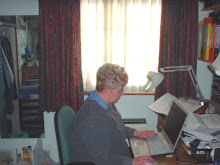In 1861 the Canadian government decided that people who lived in “large” cities like Toronto, Hamilton, Ottawa, Quebec and Montreal could fill in their own census forms. As a result, the arrangement of data varies from that used in smaller towns and rural areas. On microfilm, one form or “schedule” or “folio” covers one household and includes four pages to be filled in, mostly with the same type of information as used in the 50-people-per-page forms used elsewhere, but questions on agricultural output were replaced with questions on industrial enterprises and a description and value of the dwelling.
The designers of the census did not realize the limits of literacy within the urban population, much less the patience of the enumerators who had to transmit the information back to headquarters. Do-it-yourself census forms were not attempted again until some time well into the 20th century.
The urban form was designed with the numbers 1 to 20 down the left margin, but no horizontal lines to guide the writing across the page. This sometimes lead to ages, sexes and marital status inadvertently being omitted for one or more individuals.
Quite often the householders thought that only their surname was necessary, until the enumerator came along and told them they must put their given names in, too. As a result many forms are found with given names in the margin, often in a different hand.
The enumerators were expected to give each form a number. Unfortunately some omitted numbers or duplicated them. Headquarters must have failed to explain to them how two or more apartments or flats in one dwelling should be interpreted. Each form was supposed to have the name and side of the street written in the margin, but some enumerators omitted this instruction intermittently or altogether, and others placed it in the margin beyond the area photographed in the microfilm.
The difficulty in reading individual census forms varied widely. Some people of limited education tried very hard to do what was required of them, others depended on the enumerator writing what they reported. Detail on these latter forms was minimal.
Many with occupations that you would expect would be held by more knowledgeable members of the population misinterpreted the forms—they gave ages for each of the children and then summarized the size of the family as “3 males and 4 females” rather than giving the sex of each child.
The head of household might also decided to maintain his family’s privacy by using initials instead of full given names for each member. This left the statisticians at headquarters and the today’s transcriber with the potential for very inaccurate data.
Other problems were caused by poor penmanship, writing in pencil, writing sideways, covering vital information (like ages) with a blot, or entering a birthplace and/or a religious persuasion solely for the head of the household.
I understand that the 1911 UK Census, just available online, also allowed householders to fill in their own forms. I haven't seen it yet, but it will be interesting to assess how satisfactory the process was 50 years later.
Subscribe to:
Post Comments (Atom)




No comments:
Post a Comment